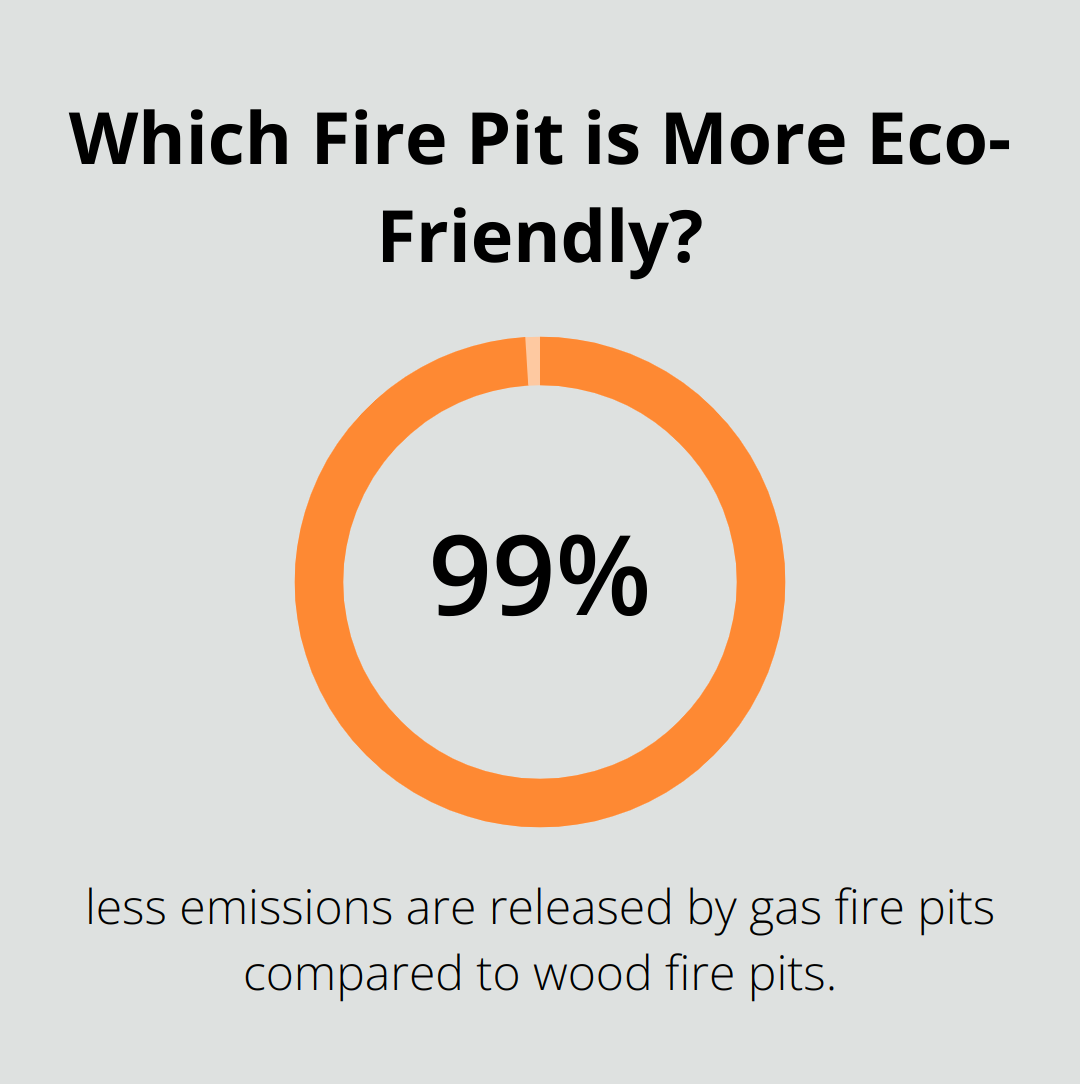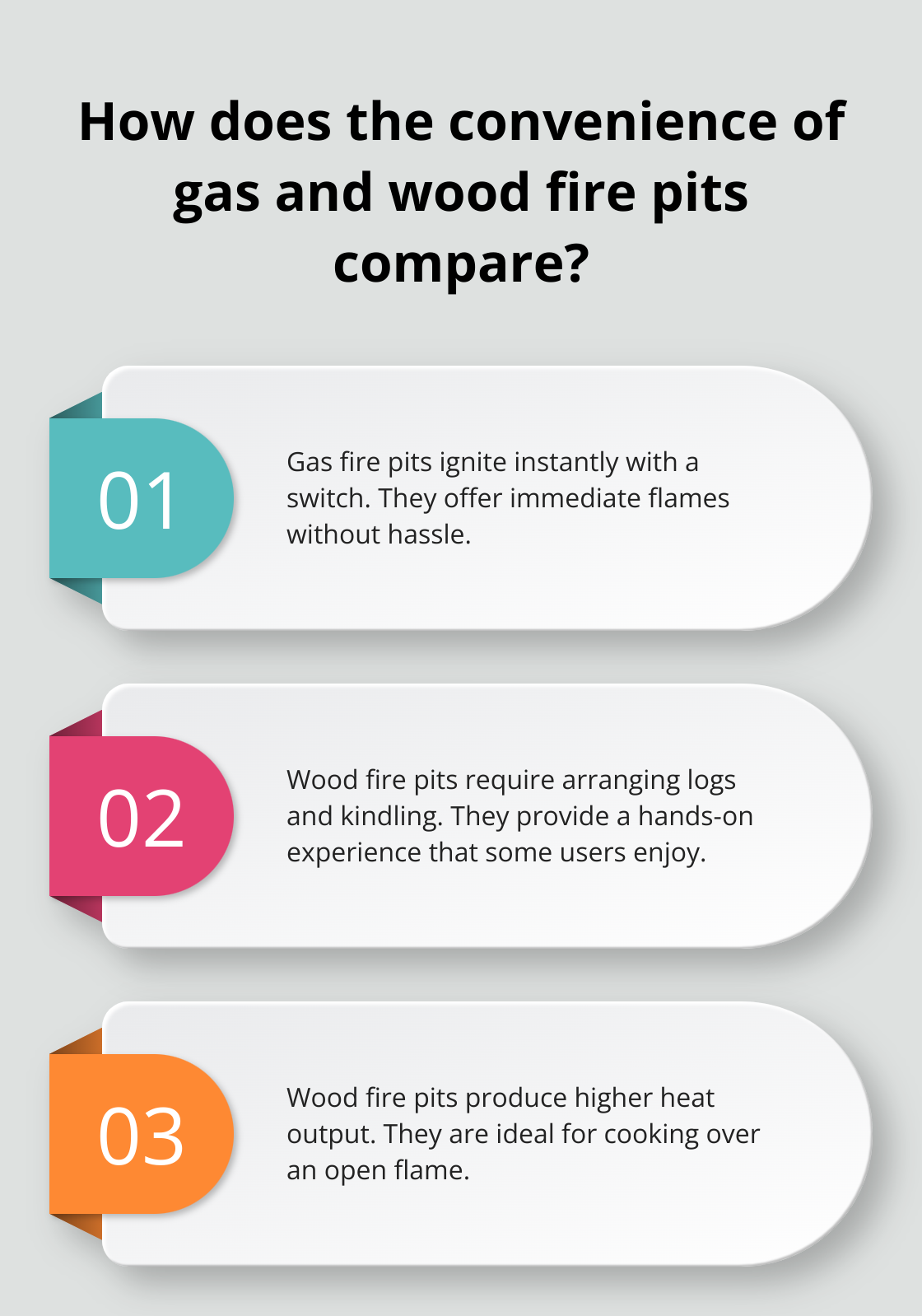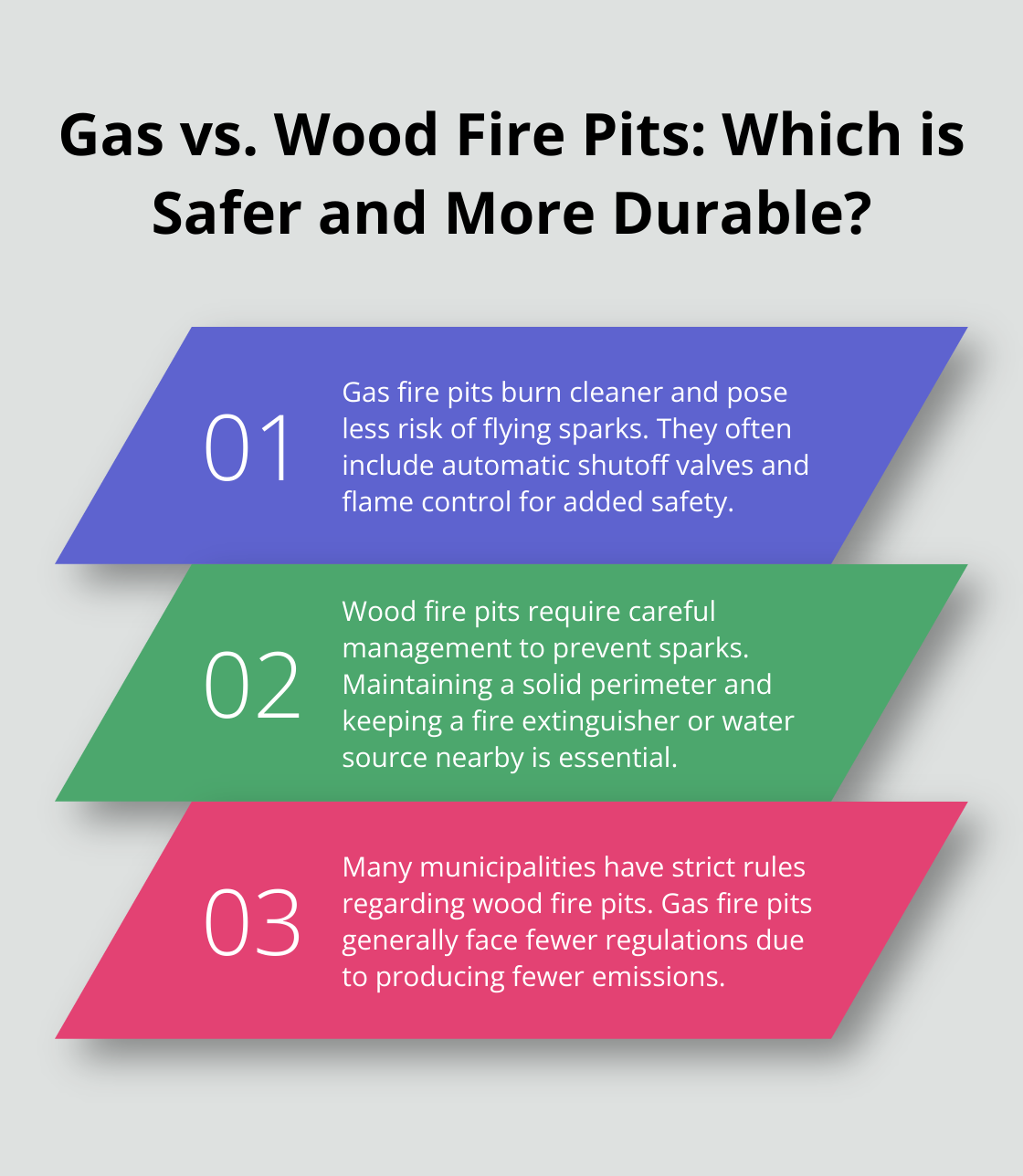
Selecting the right fire pit for your needs can significantly impact your outdoor experience.
At S&S Fire Pits, we believe understanding the differences between gas and wood fire pits is essential.
This guide will break down key factors, from fuel sources to safety features, to help you make an informed decision.
Gas vs. Wood: Key Differences
Fuel Source: Accessibility and Convenience
Gas fire pits run on propane or natural gas, which are readily available in most areas. Propane tanks are easy to replace, making it a convenient option. Natural gas lines, once installed, provide an endless fuel source without the need for storage. In contrast, wood fire pits require seasoned wood, which involves chopping, storing, and keeping the logs dry. This process can be labor-intensive and time-consuming, especially for those without easy access to quality wood. If convenience is a priority, gas fire pits certainly have the upper hand.
Initial Investment and Upkeep
When comparing costs, gas fire pits generally have a higher initial price tag. Installation can range from $900 to $3,800, primarily due to the need for professional setup. However, once installed, they require minimal maintenance, only occasional cleaning to remove any debris. Wood fire pits, on the other hand, are more affordable upfront, ranging from $500 to $1,300. They can often be a DIY project. Yet, the ongoing maintenance of cleaning ash and soot, along with the need to purchase or source wood, adds up over time. If you’re looking for a lower-maintenance option, a gas fire pit is more cost-effective in the long run.
Environmental Impact
For those concerned about environmental impact, gas fire pits are the cleaner option. They emit significantly fewer emissions—99% less compared to wood fire pits. Each use of a wood fire pit releases around 28 pounds of emissions, impacting air quality. Gas fire pit logs burn cleaner, making them a better choice for areas with strict air quality regulations or for individuals with respiratory issues, such as asthma. If environmental considerations are at the forefront of your decision, gas fire pits are the clear winner.

Understanding these practical differences between gas and wood fire pits can help you make a more informed choice that suits your lifestyle and priorities.
How Convenient Are Gas and Wood Fire Pits?
When considering a fire pit for your outdoor space, convenience and user experience play a crucial role in your decision. Gas and wood fire pits offer distinct experiences that cater to different lifestyles and preferences.
Ease of Use and Lighting
Gas fire pits provide unparalleled convenience. They ignite instantly with a simple switch, offering immediate flames without any hassle. This ease of use makes gas fire pits an excellent choice for those who want a quick and fuss-free fire. On the other hand, wood fire pits require a bit more effort. Starting a wood fire involves arranging logs, using kindling, and maintaining the flame. For those who enjoy the hands-on process, this can be part of the charm. However, for a more straightforward experience, gas fire pits are the clear winner.
Heat Output and Cooking Capability
When it comes to heat, wood fire pits outshine their gas counterparts. Wood fires produce a higher heat output, making them ideal for colder nights and larger outdoor spaces. Additionally, wood fire pits are perfect for cooking over an open flame, whether you’re roasting marshmallows or grilling. The natural heat and flavor imparted by wood are unmatched for cooking enthusiasts.

Gas fire pits, while producing ample warmth, generally offer less heat compared to wood. They are more about ambiance than intense heating. While you can still roast marshmallows over a gas flame, it doesn’t quite compare to the traditional experience of a wood fire. For those focused on cooking and higher heat output, wood fire pits are more advantageous.
Aesthetic Appeal and Ambiance
Aesthetic preferences often drive the choice between gas and wood fire pits. Wood fire pits bring a rustic, authentic charm to any setting. The crackling sounds and smoky aroma evoke a nostalgic and cozy ambiance that many find irreplaceable. This sensory experience can’t be replicated by gas fire pits.
Gas fire pits, however, offer a sleek and modern look. They come in various designs, from bowls to rectangular shapes, fitting well in contemporary outdoor spaces. They provide a clean and elegant flame without the mess of ash and soot. For those prioritizing a pristine and modern aesthetic, gas fire pits are more suitable.
Each type of fire pit offers a unique blend of user experience and convenience. Whether you prioritize the immediate satisfaction of a gas fire or the deep, rewarding experience of a wood fire, there is a fire pit option to match your lifestyle and outdoor ambiance.
Safety and Regulations
Fire Risks and Safety Features
When it comes to safety, gas fire pits have a clear edge over wood fire pits. Gas fire pits burn cleaner and pose less risk of flying sparks and unpredictable flames. This reduces the chance of starting accidental outdoor fires, which is especially crucial in dry climates. Gas fire pits typically include built-in safety features like automatic shutoff valves and flame control, providing an additional layer of protection against potential hazards.

Wood fire pits, on the other hand, require careful management to prevent safety risks. Sparks from wood fires are unpredictable and can ignite surrounding areas if not properly contained. It’s essential to maintain a solid perimeter around the pit and keep a fire extinguisher or water source nearby. Regularly checking and cleaning the pit from ashes and debris can also minimize fire hazards.
Local Regulations and Permit Requirements
Understanding local regulations is vital when deciding between a gas and wood fire pit. Many municipalities have strict rules regarding open flames. In some areas, wood fire pits might require a special permit, particularly in regions prone to wildfires. Local ordinances can sometimes prohibit wood-burning fire pits entirely to reduce air pollution and fire risks.
Gas fire pits are generally subject to fewer regulations because they produce fewer emissions and are considered safer. However, the installation of natural gas lines often requires a permit and must be handled by a licensed professional. Always check with your local government or homeowners association to ensure compliance with all rules and regulations before installation.
Long-Term Durability and Weather Resistance
In terms of durability, both gas and wood fire pits can last for many years with proper care. Gas fire pits, constructed from materials like stainless steel, glass, or concrete, are often weather-resistant and require minimal upkeep. Simple tasks, like covering the fire pit when not in use and regular cleaning, can extend the life of the unit.
Wood fire pits, particularly those made from cast iron or steel, need more care to prevent rust and wear. Regular cleaning to remove ash and moisture is crucial. Using a weather-resistant cover can help protect it from the elements. Additionally, the high heat output of wood fires can cause certain materials to deteriorate faster, so periodic inspection and maintenance are important.
Choosing between gas and wood fire pits involves weighing not only the fire risks and safety features but also understanding local regulations and the long-term durability of your setup. This decision will significantly impact how you use and enjoy your fire pit over time.
Conclusion
Selecting the right fire pit can profoundly enhance your outdoor living experience. Gas and wood fire pits each offer unique benefits that cater to different preferences and lifestyles.

Gas fire pits stand out for their convenience, cleaner burning, and low maintenance. They ignite quickly and require minimal upkeep, making them an ideal choice for those who value ease of use and modern aesthetics. The reduced emissions and built-in safety features also make gas fire pits a safer and more environmentally friendly option.
Wood fire pits, on the other hand, offer an authentic, rustic experience. The crackling sounds, smoky aroma, and higher heat output are perfect for those who cherish the traditional feel of a campfire and enjoy cooking over an open flame. They are generally more affordable upfront and can be a great DIY project, although the ongoing maintenance and fuel storage requirements are more intensive.
Your choice between gas and wood fire pits will ultimately depend on your priorities, whether they lie in convenience, environmental impact, cooking capabilities, or the traditional fire pit ambiance. Understanding the practical differences can help you make a well-informed decision that aligns with your needs and enhances your outdoor space.
Visit S&S Fire Pits to explore our range of handmade, unique fire pits and products crafted from corten solid USA steel. Each piece is built by hand, guaranteed for life, and designed to provide a high-quality experience that never needs replacing.


